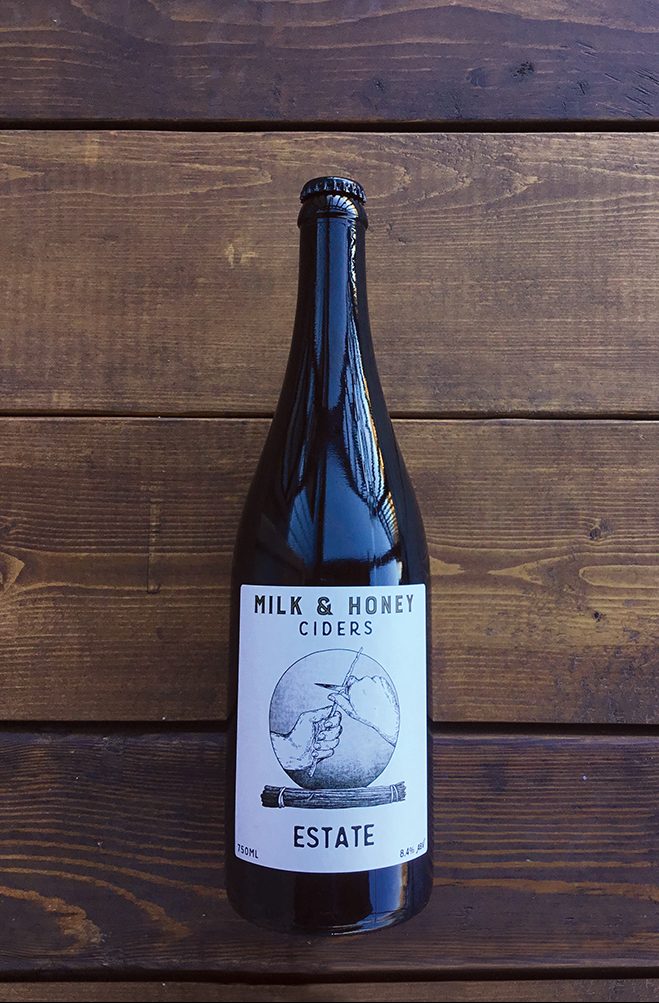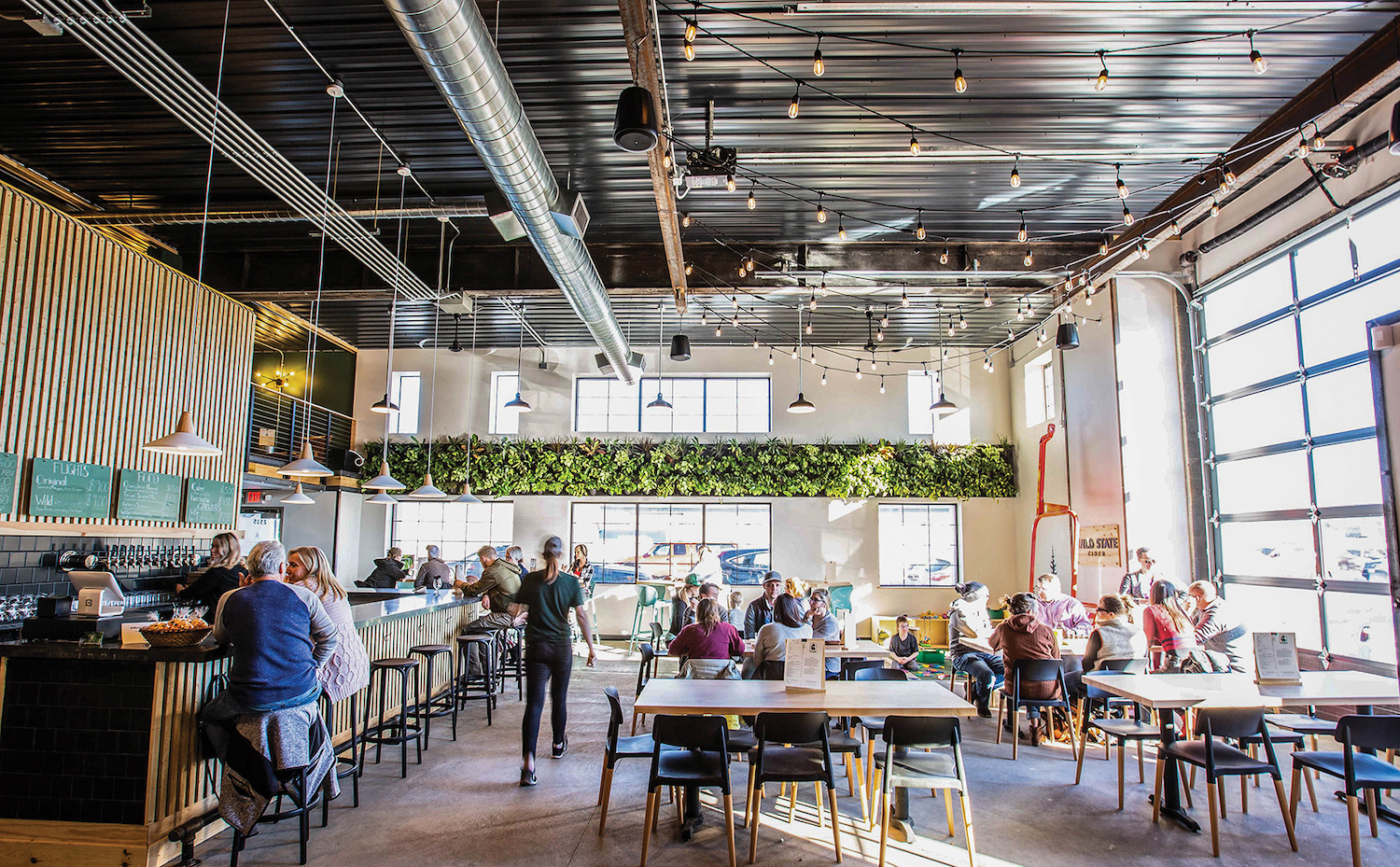🔗 “Orange creamsicle? Huh…I’ve gotta try that.”
That’s not what we expected to hear after setting a six-pack of regional ciders on the counter at Zipps Liquors, including a couple smoothie-inspired selections from the Fargo-based cidery Wild Terra. Indifference? Sure. Silent judgment? Most definitely.
The clerk then scanned a can marked with nothing but a smudged blue stamp from the Dundas-based Keepsake Cidery—a sly design choice considering the funky, wine-like cider within it. A drink this dynamic begs the question: Does the cider market really need orange-creamsicle overtones when liquor stores are already overloaded with second-class White Claws and IPAs that are way too reliant on milk sugar and marshmallows?
Yes, apparently. And why not? When they’re done well, apple-adjacent ciders can be quite compelling. A revelation, even—one that’s rooted in restraint and bushels of beautiful fruit rather than artificial flavors and additives.
A few other adjunct-infused experiments we enjoyed over the summer included Milk & Honey’s subtle trip through the tropics (Pineapple Coconut); Minneapolis Cider Co.’s slightly herbal and not too puckery Lemon Lavender Shandy; and Wild State’s berry-and-stone fruit-blasted Sangria.
All these highly accessible hits left us wondering: While Minnesota’s old-world adopters (Keepsake being a prime example) are more than capable of making pure magic happen from nothing but fresh-pressed apple juice, wild yeast, and time, does anyone care? Or are they bound to buy whatever sounds like dessert?
Ask anyone in the business of making hard cider, and they’ll tell you there’s more than enough room in the beverage world for both traditional and tricked-out varieties. That’s a prime selling point for the local cider scene: its open-minded mix of minimalism and maximalism. Or as Keepsake co-founder Nate Watters puts it, “I am probably considered a purist, but I don’t judge others for making or enjoying what I might consider gimmicky. I like all the creativity. There is a Minnesota-made cider for everybody—dry, medium, sweet, fruited, barrel-aged, fortified, even non-alcoholic.”
“It’s a delicate balance when introducing outside flavors to your cider,” adds John Knisley of Tallgrass Cider, arguably the smallest of small-batch makers in the state. “But at the same time, why not let your creative juices fly? I mean, some people like coffee with cream and sugar, and some like it without; either way, it’s still coffee.”
Personal preferences aside, it’s no wonder why cider went from being something curious drinkers might try at the Sociable Cider Werks taproom to a matter-of-time movement. After all, Minnesota has long been recognized for its role in developing revolutionary apple varieties (SweetTango, First Kiss) and grocery store greats like the Haralson and Honeycrisp. Highlighting their strengths with a hint of alcohol is to be expected and embraced.

Cider culture—fledgling as it may be—is a very natural fit with Minnesota’s climate, landscape, and sense of place,” explains Milk & Honey co-founder Peter Gillitzer. “We have a deep agrarian history here with our productive soils, abundant rainfall, cold winters, and warm summers. It just feels like a beverage that Minnesotans should enjoy—very low-intervention: just crush fruit and wait. You don’t have to add anything to it.”
With that in mind, we asked up-and-coming cider producers what they’ll have coming this fall, from wild-fermented wonders to single-variety stars:
Duluth Cider (Duluth)
“Our Chai spiced cider is like fall in a can. The blend of cinnamon, vanilla, clove, and a slew of other spices balances perfectly with apples to conjure up all the fall feels.” –Jake Scott
Keepsake Cidery (Dundas)
“We love our River Valley Reserve and Orchard Reserve. Those are both dry [naturally carbonated] pét-nats. For something a bit sweeter, I am partial to our Wood & Spirits Medium, a cider aged in whisky-soaked staves from Loon Liquors Distillery here in Northfield.” –Nate Watters
Milk & Honey Ciders (St. Joseph)
“Our Estate release each year features all of the best apples from our orchards in Cold Spring and St. Joseph. It is fermented with the native yeast communities on the fruit and in the cider house. We simply press the apples and let them ferment—low and slow. The orchards have a distinct thumbprint; the expression of the climate, soil, growing conditions of central Minnesota is imparted in the glass.” –Peter Gillitzer
Minneapolis Cider Co. (Minneapolis)
“[This is] our Blueberry Borealis collaboration with Friends of the Boundary Waters Wilderness. In addition to just being a delicious cider, we donate $1 from each glass and four-pack sold in the taproom to support their work to protect the Boundary Waters Canoe Area and scholarships that make the Boundary Waters accessible to more kids from across Minnesota.” –Jason Dayton
Number 12 Cider (Minneapolis)
“Fred is a beautiful, dry, single-varietal cider made only from the Champagne apple, which is grown exclusively at Dixon’s Apple Orchard near Eau Claire. The story goes that around 1944, Fred Dixon discovered a wild apple tree on his New Mexico orchard and decided the apples were so delicious he would plant an abundance around the property. He later trademarked it as the Champagne Apple, which is now grown beautifully by his granddaughter Becky at Dixon’s. This truly unique cider ages for 8-10 months, ending up dry and slightly tropical with a floral essence and a hint of spice. It’s delicious.” –Colin Post
Sweetland Orchard (Webster)
“It might be a toss-up. No Fair is an Arnie Palmer-inspired cider made with lemon juice and TeaSource’s iced tea blend. Then we’ve got a single-variety, estate-grown Golden Russet from the 2019 harvest. It needed that long to mature and it tastes amazing, with a rich texture and a flavor reminiscent of black walnuts. It will be very much appreciated by cider aficionados.” –Gretchen Perbix
Tallgrass Cider (Madelia)
“Wayward is a fully wild-fermented cider that is made from late-season apples harvested in 2020. When I say ‘wild-fermented,’ I mean that no commercial yeasts or flavors were added to the cider; it’s just apple juice and time. Making a wild-fermented cider is sometimes considered riskier because of variables like fermentation time, getting a fully dry cider, and other spoilage issues. It has been my experience that a wild fermentation takes roughly twice as long as a fermentation with a commercial yeast, but often yields a delicious cider.”
–John Knisley
Wild State Cider (Duluth)
“We’re doing a 12-pack sampler for the first time this fall. It’s going to include an imperial (8% alcohol), apple-forward cider; a pumpkin pie cider that has real pumpkin in it; a cider utilizing late-summer berries; and a peach basil cider. It’s mostly an experiment for us. When we put a bunch of exclusive ciders together, how do they all do out there in the world?” –Adam Ruhland

